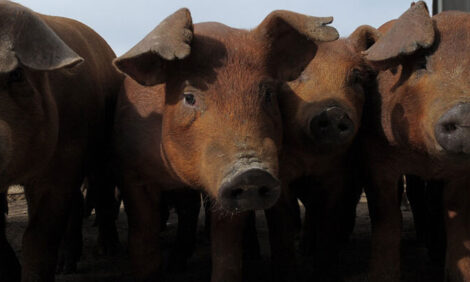



Boar Taint Vaccine Improves More Than Welfare
A new vaccination that inhibits boar taint in meat has also been found to have other benefits for the pig producer by improving feed efficiency and delivering a leaner carcass with better meat quality, writes ThePigSite senior editor, Chris Harris.The Improvac vaccine, developed in Australia and having been on the Asia Pacific market for several years, was launched onto the European market earlier this year. The vaccine developed by pharmaceutical company, Pfizer Animal Health, has yet to be authorised for the US market.
The vaccine was brought on to the market as a means of reducing the possibilities of boar taint without castration.
Boar taint - the offensive smell and taste in pig meat - is caused by compounds that accumulate in the fat as male pigs become sexually mature.
The two main taint compounds are androstenone, which is produced in the testicles and skatole, a by-product of bacterial activity in the gut.
The level of androstenone is directly controlled by the activity of the testicles and increases dramatically as the pig reaches puberty.
The breakdown of skatole, which is produced by both male and female pigs, is inhibited by testicular function and tends to accumulate in male pigs.
Across Europe there are specific levels of the two that are allowed in pig meat – 1mg of androstenone per gram belly fat and 2mg of skatole per gram of belly fat.
Traditionally, castration has been used to prevent the build-up of these compounds and in Europe, about 100 million male piglets are castrated. In some cases, boar taint is avoided by early slaughter, as in the UK, but for processing systems and country tastes that require a heavier pig, castration has been essential.
However, the experts at Pfizer say that early slaughter still runs the risk of boar taint and as the pigs are intact, there is also a greater risk of undesirable behaviour such as mounting and aggression.
While in some countries the piglets are anaesthetised, there are still welfare issues to be considered as well as the financial costs to the farmer for the castration.
The vaccine, Improvac, blocks testicular function and reduces testosterone levels, so that the boars demonstrate much less behaviour such as mounting and fighting later in thr finishing phase.
The pigs become easier to manage and show both physical and behavioural changes.
Pfizer says that with the vaccination, it is possible to maintain quality assurance in the production unit.
Improvac has a zero day withholding time before slaughter, so there are no concerns about affecting human health.
The treatment requires two vaccinations. The first comes at eight weeks of age and the second vaccination four to six weeks before slaughter. With the treatment, androstenone and skatole fall to negligible levels.

In consumer tests, the meat quality improves and it is shown to be at least equivalent to that of castrated pigs or female pigs, and it is significantly better than non-vaccinated boars.
Market research among consumers shows that the majority prefer to see the use of the vaccine rather than castration - 71 per cent in France, 61 per cent in Germany and 74 per cent in the Netherlands.
However for the producer one of the major benefits is that vaccinated pigs also show better feed conversion rates.
Dr Michael Pearce from Pfizer said: "Studies have shown an improvement in feed conversion with the pigs eating 10 per cent less feed.
"The lean meat content of the pigs is also one to three per cent higher in whole vaccinated pigs rather than castrated pigs.
"The backfat is 10 to 15 per cent less than in castrated pigs."
Dr Pearce added that a high protein and high energy diet appears to work best and give the best feed conversion rates.
The vaccinated pigs grow in the same way as entire male pigs, giving an advantage at the abattoir.
Part of the reason for better feed conversion is the changes that are seen in the behaviour of the vaccinated pigs and the better carcass quality is because there is less stress and aggression and this means better meat quality and fewer skin lesions. It also has the effect of producing less PSE (pale soft exudative) and DFD (dry firm dark) pig meat.
With the better feed conversion rates, there are also environmental benefits as less slurry is produced.

July 2009








